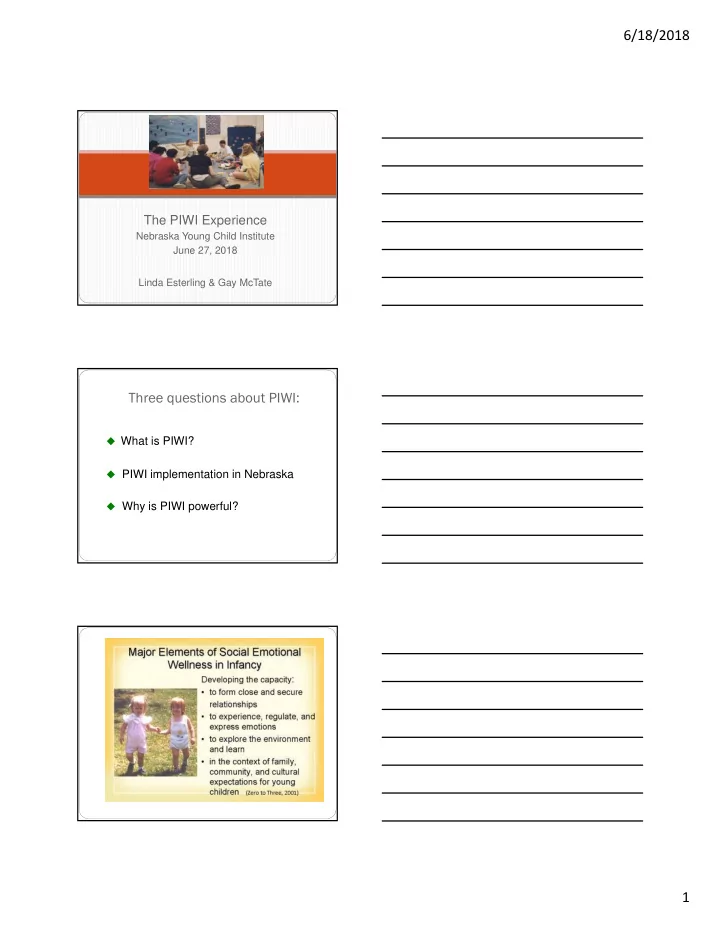

6/18/2018 The PIWI Experience Nebraska Young Child Institute June 27, 2018 Linda Esterling & Gay McTate Three questions about PIWI: What is PIWI? PIWI implementation in Nebraska Why is PIWI powerful? 1
6/18/2018 2
6/18/2018 Our focus will be on ways of interacting with parents that . . . Supports competence, confidence, and positive relationships at both the facilitator-parent-child level and the parent-child level Keeps the parent-child relationship at the center of everything we do – by supporting responsive, respectful parent-child interactions Typical pical PIWI PIWI Sch Schedu dule f for a r a Paren Parent-Child ld Gr Grou oup Greeting/Welcome 10 min Arrival Informal Conversation Hello Song Opening Discussion 15 min Sharing Introduce Developmental Observation Topic The “Guess” Parent-Child Observation Time 25 min Snack 15 min Parent-Child Songs and Games 10 min Closing Discussion 15 min Sharing What Happened Carry Over to Home Goodbye Song Characteristics of Mutually Satisfying Interactions Shared emotion Joint attention Predictability Reciprocity/Turn-Taking 3
6/18/2018 Temperament Types Flexible Shy Feisty Regular rhythms Adapts slowly Active Positive mood Withdraws Intense Adaptability Distractable Low Intensity Sensitive Low Sensitivity Irregular Moody Why is understanding temperament im impo portant in relation to social emotional de developm pment? • Helps us be more nurturing, responsive and effective • Children get message it’s okay to be who they are • Helps support “goodness of fit” • Helps us better “Match” child 4
6/18/2018 Turning Dyadic Interaction Characteristics Into Strat Strategi gies ….any alterations or additions that the adult intentionally uses during adult-child interactions to facilitate a better match with the child and to foster his/her development. The Goals of Dyadic . . . Increase confidence and competence to: • “read” the child’s messages • respond to the child’s messages • experience fun together Maintain Child’s Interest and Attention Establish self as an interesting partner Maintain warm, encouraging manner Provide clear emotional signals Use novelty and exaggeration to capture interest Be sensitive and responsive to child’s emotional expressions Regulate pace of interaction in response to child’s mood and emotional cues Recruit child’s attention when unengaged or unfocused Introduce new focus or activity when needed 5
6/18/2018 Establish Reciprocal Roles Turn-Taking Respond to child’s initiations Establish predictable, reciprocal interaction routines Provide time for child to take a turn Let child know that a response is expected . . . then WAIT Imitate . . . then WAIT Match and Follow Wait, Watch and Then Join in Wait and watch to see what the child is interested in, how/what the child is playing ad then join the child’s play by following their lead and matching their focus of attention/interest Comment on child’s activities and interests Acknowledge child’s emotions 6
6/18/2018 What are triadic strategies? Triadic Interaction Strategies are those . . . used by the facilitator during parent-child interactions to expand and build interactions that are pleasurable for both partners and supportive of children’s development while also recognizing and strengthening the natural competence of parents as they interact with their children. Triadic Strategies Least to Most Establish a Dyadic Context Affirm/Acknowledge Parenting Competence Focus Attention Provide Developmental Information Model Suggest 7
6/18/2018 Triadic Rules to Guide the Facilitator Put yourself in the parent’s shoes in order to achieve the right level of support Think about the strengths of the dyad Think about the key outcomes of supporting confidence and competence Be careful with “modeling” and “suggesting” Choose the least directive/support triadic strategy and then wait, watch and adjust Parents as Observers • Content … _ respect my agenda • Process … - uses my preferred learning style - matches where I am - changes as I change • Relationship - is sensitive, responsive, positive, respectful 8
6/18/2018 Two Approaches to “soften” the facilitator input” Use the child’s voice Use indirect statements - “I wonder what would happen if you …” - “Sometimes he seems to like it when you …” - “Some children respond if you …” - “Yesterday I saw you …” Why Parents as Observers? Benefits to Parents: Benefits to Children: - Better understand what their - Practice and demonstrate child is like what they can do - Experience pride in what - Expand what they already their child can do do, know, and feel - Better understand their role - Gain confidence and feel in supporting their child’s good about themselves development - Have fun with their - Gain confidence in parent(s) supporting their child’s development and learning - Have fun with their child Why Focus? Focusing Better Observations Better Interpreters More Accurate Interpretations Sensitivity & Responsiveness Better Supporter of Child’s Development 9
6/18/2018 DOT Definitions… A Developmental Observation Topic …an aspect of children’s development that is selected as an organizer for parents’ observations, based on parents’ concerns and interests and on children’s developmental agendas, as stated from the child’s point of view …a framework for planning environments and activities that support parents’ observations and understanding of their children’s abilities, inclinations, needs, feelings, and of the influence of physical and social environments on how children express their development. 10
6/18/2018 PIWI in Nebraska Counties with PIWI: Dodge - Fremont Lincoln - North Platte Dakota - South Sioux City Platte-Colfax - Columbus Madison - Norfolk York - (planned for fall) Pr Promo omoting Saf Safe and Sta and Stable F e Families es Ev Evaluation Report o on PIWI 2016 016 – – 201 017 Un Universit sity o of Nebraksa sa Medic dical C l Center Families Served Directly 124 Indirectly 4 Children Served Directly 115 Indirectly 62 Staff Participating 19 Organizations Participating 14 64% of Participants at Risk Due to Poverty 11
6/18/2018 Parents who participated in PIWI with their children demonstrated significant improvements in: Concrete Supports and Nurturing and Attachment. In Summary The PIWI Model Components: PIWI Philosophy Dyadic Strategies Triadic Strategies Developmental Observation Topics PIWI Environmental Plans Why is PIWI Powerful? 12
Recommend
More recommend